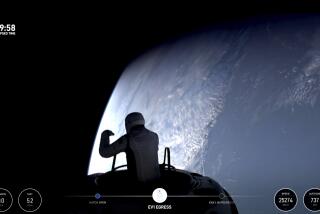It Could Be One Giant Leap for Vacationers
- Share via
The ad said “Help Make Space History!” and from a buff-painted classroom solidly on the ground in Claremont, eight civilians did.
For 45 hours this weekend, Mission Control was a psychology professor, and the command module was equipped with microwaves and video. But for the eight volunteers, it was the closest they may get to interplanetary travel.
One was a 46-year-old homemaker who watches “Star Trek,” reads science fiction and dreams of traveling among the stars. Another, a 30-year-old man, always wanted to be an astronaut but was forced by poor vision to become an aerospace engineer instead. One unemployed church secretary just said she knew she would never again get this close to flying in space.
The eight were chosen from people who answered a newspaper ad for the McDonnell Douglas-Claremont McKenna College experiment designed to answer the question: Can space ever be as enjoyable a vacation as Spain?
The aerospace firm maintains that the stars will soon be within reach to those who can afford the hefty price tag for the trip. By 2005, the company expects to market a four-day orbiting holiday at a likely price of $100,000. So it has to find out how average people--at least average people who take six-figure vacations--would take to the demands of living in a spaceship.
For the 45 hours that these eight volunteers, ages 30 to 74--the second group to take part in the experiment--would spend in the 25-feet-by-16-foot room, they wouldn’t pay a cent. Each received $100, McDonnell Douglas trinkets including a T-shirt and a mug, and a wondrous weekend of pretend-life in a space shuttle.
“I would have paid them,” said Lee Scott, the “Star Trek” fan, after she emerged from her 45 airborne hours.
Students at Claremont McKenna College helped design the experiment, which was supervised by professor Harvey A. Wichman, who served as the voice of mission control while the students recorded every moment of the “journey” except the personal ones.
“I’ve been interested in space travel since I was a little kid,” said Gary Blinn, 42, a quality control manager who volunteered along with his wife, Mary. “This was a way to be a part of the space program just a little bit.”
Every minute of the weekend was structured, just as it might be on a real spacecraft. Fifteen minutes were allotted for each briefing with mission control. Five minutes for completing an hourly survey. An hour and five minutes for mock experiments, like building models, 10 minutes for bathroom breaks in the adjoining portable toilet, 30 minutes for “interactive play” (board games like Pictionary) and eight hours for sleep in bunks stacked three high.
To be sure, there were varying reactions to the close quarters, competitive projects, rigid schedules and the piped-in noises of humming engines and rushing winds.
The aerospace engineer was grumpy Sunday morning after a sleepless night listening to others’ snores. Like any flight crew, they all had to leave the module at the same time--to a throng of applauding students--so a few waited in frustration as their fellow terra-nauts labored over exit surveys.
None of that surprised the student researchers. In addition to studying how people react to what are known as “severe environments,” the students were testing two hypotheses: that people need to be trained to enjoy life in a severe environment, and that interpersonal tensions on “flights” peak at midpoint and near the end.
“They emerged just as happy as when they went in,” said Claremont student Crystal Hoyt. “That’s the point, to send people on a vacation and have them have a great time.”
That’s welcome news to William A. Gaubatz, the program manager at McDonnell Douglas, who extols to participants and anyone else who will listen the imminence of space tourism--hotels among the stars, point-to-point travel on Earth in 50 minutes or less, all with space shuttle technology.
Wichman was waiting when the eight exited the module.
“When your grandchildren ride in these rockets, you can tell them, ‘I was there when it began,’ ” he said.
More to Read
Sign up for Essential California
The most important California stories and recommendations in your inbox every morning.
You may occasionally receive promotional content from the Los Angeles Times.













